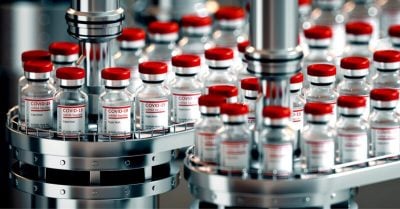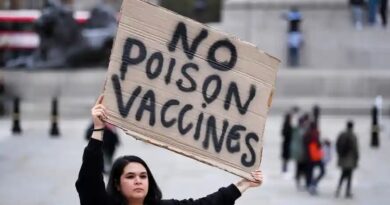FDA Panel Votes to Waive Clinical Trials for New COVID Boosters

The U.S. Food and Drug Administration’s vaccine advisory panel voted 19 to 2 on Tuesday to add an Omicron component to COVID-19 boosters this fall, over objections by panel members and despite a lack of data.
The U.S. Food and Drug Administration’s (FDA) vaccine advisory panel on Tuesday voted 19 to 2 to recommend new COVID-19 booster shots that include the Omicron variant this fall.
The FDA’s Vaccines and Related Biological Products Advisory Committee (VRBPAC) did not issue guidance on whether additional data would be needed to recommend an updated composition of the primary-series vaccines authorized for emergency use in the U.S., or whether it would be appropriate to continue to use a primary-series vaccine as a booster.
It is the first time VRBPAC has suggested vaccine makers modify their vaccines to target a different variant, according to CNBC, which also reported the FDA will likely accept the committee’s recommendation.
If so, the FDA would be authorizing a vaccine change without requiring additional data showing a bivalent vaccine — containing both the original 2019 Wuhan variant and one of the Omicron variants — is safe and effective for those age groups that are already authorized to receive a booster dose.
The FDA plans to decide by early July whether vaccines will target the now-dominant BA.4 and BA.5 Omicron subvariants or the BA.1 Omicron variant that led to a surge in infections last winter, Reuters reported.
At the beginning of the meeting, Dr. Peter Marks, director of the FDA’s Center for Biologics Evaluation and Research, suggested a newly designed shot could begin in October, adding that it takes manufacturers around three months to choose a vaccine design and begin producing doses.
Dr. Paul Offit, director of the Vaccine Education Center and professor of pediatrics in the Division of Infectious Diseases at Children’s Hospital of Philadelphia, and Dr. Hank Bernstein, professor of pediatrics at Zucker School of Medicine, were the only two members who broke from the panel to vote against the initiative.
Offit acknowledged there’s a benefit to providing a booster in the fall to some age groups, but questioned whether Omicron was the right strain. He said the move to new-variant vaccines was happening too fast, with too little data.
“I think as a new product it should be handled as a new product,” Offit said. “I think we need a higher standard than what we’ve been given. …“I’m not comfortable enough to support the risk of a new product.”
Bernstein expressed concern over the lack of data used to justify changing the strain, and the potential that by the time a subsequent booster is approved, it will contain outdated strains.
“So, in sum, I think including an Omicron strain in the vaccine seems to have some potential, but data especially for BA.4 and BA.5 are limited at this time, and that’s why I’m struggling to even make a strain change at this time,” Bernstein said.
Bernstein also said he didn’t see a need to change the strain as the current vaccine being used is shown to be effective against severe disease — a claim made just two weeks earlier at a prior VRBPAC meeting.
Bernstein said the strain change would need to be supported by data showing improved vaccine effectiveness and he “didn’t think we really have the data to be able to say that” even though the panel looked at the immune response.
Dr. Ofer Levy, VRBPAC member and an infectious disease physician at Boston Children’s Hospital, voted “yes” to change the computation of COVID-19 boosters, despite Pfizer’s admission there is “no established correlate of protection,” referring to the level of antibodies needed to confer protection.
“You have a lot of data now,” Levy told Pfizer. “What is your relative protection?”
“I would say there is no established correlate of protection,” Kena Swanson, Ph.D., vice president of viral vaccines at Pfizer, told Levy.
Levy circled back during the meeting:
“I would like to hear from FDA what their overall approach will be around improving our understanding of correlate protection. We spend a good amount of time reviewing antibody data. We have no doubt antibody data is important. We don’t have a level of antibody that anybody is comfortable stating is correlated [with] protection.
“So yes, the antibodies are important but so are the T cells. We heard from Dr. Weir, yes, T-cell assays are trickier and they’re more diverse, but it’s not going to happen without federal leadership to have a standardization of the T-cell assay and encourage or in fact require the sponsors to gather that information.”
“So what is the effort to standardize the pre-clinical assays?” Levy asked. “This is an effort that’s critical not just now but for future cycles of vaccine revision. If we aren’t able to define a standard for correlate protection we are fighting with one arm behind our back.”
Marks acknowledged the importance of Levy’s question, but said T-cell-mediated immunity was “difficult to study” initially.
“We have been having conversations with our colleagues at the NIH [National Institutes of Health] and throughout government about how we might move forward here,” Marks said. “It is something that we don’t have an answer to yet.”
Marks said as vaccines are developed in the future, it will “become even more important” to define a standard of correlate protection because “we won’t be able to have a large naive population to vaccinate with newer vaccines.”
“We will need to understand the T-cell response better,” Marks said. “I take your point, it’s just that we haven’t solved the problem yet.“
Dr. Meryl Nass, a member of the Children’s Health Defense scientific advisory committee, told The Defender that in her opinion, Tuesday’s meeting was a “vote to essentially approve a future framework — the future framework being a dearth of evidence required to change the booster, without clinical evidence and without a correlation of protection.”
Nass added:
“They voted on using an Omicron variant in the next booster iteration — which could contain any Omicron variant and could be either mono- or bi-valent.
“But most likely they will keep the current version and add another — which might double the amount of mRNA, or not.”
The new formulation might be for adults alone or adults and children, or only older adults and the immunocompromised, Nass said.
Brian Hooker, Ph.D., Children’s Health Defense chief scientific officer and professor of biology at Simpson University, told The Defender:
“The proposed move by VRBPAC will increase the harm to the U.S. public to unprecedented levels, as this action will further circumvent necessary clinical trials even beyond the slapdash testing of COVID-19 vaccines under Emergency Use Authorization.
“This adds to a foundation of lies used to authorize the original COVID-19 vaccines without anywhere near proper testing.”
Dr. Cody Meissner, VRBPAC panel member and professor of pediatrics at Tufts University, expressed concern about the financial risk pharmaceutical companies “are taking by making these vaccines.”
“If there’s a low likelihood the vaccines will be recommended, then they could incur significant loss,” he said.
Marks responded:
“I guess I would say that I would make recommendations here knowing the vaccine manufacturers will be kept whole by the United States government at least for some vaccines. I could be wrong but I think that’s a reasonable assumption.”
During the meeting, Moderna told the panel it would be ready with a “couple of hundred million” bivalent, or double-targeted, vaccines designed to combat BA.1 by September, but it would be late October or early November if the company needs to design a new vaccine targeting subvariants.
Pfizer said it and partner BioNTech have a significant amount of vaccine doses designed for the BA.1 variant ready and are already preparing to produce a large number of doses targeting BA.4 and BA.5 Omicron subvariants.
Pfizer said either could be ready for an early October rollout.
Multiple concerns raised during the public comment session
During the public comment session of the meeting, experts raised concerns that were largely ignored by the advisory panel.
Dr. Dustin Bryce, with Interest of Justice, said the FDA, Centers for Disease Control and Prevention (CDC) and the World Health Organization are “usurping Congress’ definition of a vaccine — which is any substance designed for the prevention of one or more disease.”
“FDA actually classifies mRNA as gene therapy, which they say is to treat or cure an existing disease by modifying your genes,” Bryce said. “Gene therapies are still being studied and are experimental at this time.”
Citing FDA documents, Bryce said gene therapy, unlike a vaccine, is so inherently unsafe the FDA says it requires 15 years of research to follow up on safety due to known risks of antibody-dependent enhancement, alteration of DNA and delayed adverse effects, such as cancer.
Bryce said:
“FDA says that gene therapy use in the mass population represents an unreasonable risk and they should limit the number of subjects who might be exposed to risk. We require due process and forbid the FDA from authorizing the proposed changes.
“We are demanding that EUA [Emergency Use Authorization] is promptly revoked because unreasonable risks are inherent in gene therapy products, as evidenced by large numbers of reports of adverse serious events linked to or suspected of being caused by an EUA product, product failure and product ineffectiveness.”
Bryce said COVID-19 vaccines fail to meet the requirements of EUA because not a single mRNA vaccine has been found to be effective for the prevention or treatment of an existing disease.
Michael Briskin pointed out in his public comment that the FDA receives approximately 75% of its budget from pharmaceutical companies, which he believes represents a conflict of interest.
Briskin challenged the use of the phrase “safe and effective” to describe COVID-19 vaccines, given the FDA has done no long-term testing to determine whether these products are safe.
Briskin presented data showing a significant rise in reported deaths among working-age Americans following COVID-19 vaccine mandates.
He said:
“In the short-term, 2021 was a very interesting year. We saw a stark increase [in death] among working-age adults from 18 to 64 and specifically in Q3 and into Q4, so something new for the working-age demographic partly through 2021 would be the clear correlation.
“With comparable trends in BLS [Bureau of Labor Statistics] data, children’s health insurance data, Israeli ambulance data, and of course we have the [Vaccine Adverse Event Reporting System (VAERS)] data — which the CDC tried to minimize but a recent FOIA [Freedom of Information Act] request forced them to reveal that they never once did the PRR calcification that was supposed to be their tool for spotting safety signals, according to their posted documents.”
“And what do we do when people get injured from these vaccines?” Briskin asked the panel. “We leave them in the mud.”
Briskin chastised the panel for authorizing boosters for infants two weeks earlier when data showed two doses weren’t effective and only 10 cases were used to assess efficacy.
“Three-quarters of the severe COVID in the trial was in the vaccine arm, as was the only hospitalization case which was accompanied by a seizure,” Briskin said. “And Moderna is so dangerous in young people Nordic countries won’t allow it to be used in anyone under the age of 30.”
Briskin said:
“In fact, the director of health of Denmark just admitted that vaccinating children was a mistake, whereas our officials only ever doubled down. And now we’re about to double down so hard we are about to lose the pretense of holding these pharmaceutical companies to any statistically meaningful regulatory standards for formula modification.
“For people following at home, what this agency is proposing is not just modifying the genetic code in the vaccine and the structure of the proteins produced to chase variants, but even things like doubling the microgram count for Pfizer — all without doing any statistically powered safety studies.”
“And to be clear,” Briskin added, “the companies we’re giving carte blanche to include Pfizer, the world’s largest criminal organization having paid the world’s largest criminal fine, and Moderna, which never made a safe product before we did away with long-term safety testing.”
Dr. Eric Feintuch, a chiropractor, asked the FDA if the agency knows how long mRNA from COVID-19 vaccines and the spike protein stay in the body, whether they know what the rate of protein production is and whether the FDA is aware of the consequences of the methylpseudouridine substitutions at the codon optimization step.
“For anyone on this panel who says it doesn’t go anywhere, tell me what proof you have of that,” Feintuch said, referring to the spike protein.
Feintuch said COVID-19 vaccines are associated with prion disease, noting 26 people have reported experiencing sudden onset of a severe and fatal brain disorder within one month of the second mRNA vaccine dose.
“This information needs to be researched and seen,” Feintuch said.
“A thousand peer-reviewed studies question the safety of COVID-19 vaccines. Doesn’t anyone see the safety signals? Is there anyone here who will stand up?” he asked. “Some of you know this, you need to stand up and you need to help us.”
Dr. David Wiseman, a research scientist with a background in pharmacy, pharmacology and experimental pathology, said VRBPAC is once again being asked to opine on inadequate information.
Wiseman said the FDA recently waived efficacy requirements for COVID-19 vaccines and has ignored its experts, notably Levy, who “has called for federal efforts to validate and standardize a correlate of protection.”
“Recent vaccine decisions were based on irrelevant Wuhan immunobridging,” Wiseman said. “Omicron assays are unvalidated and unverified by FDA.”
Wiseman said safety questions surrounding COVID-19 vaccines remain unanswered:
“We have shown correlations between vaccination and all-cause mortality. FDA says VAERS is under- and misreported. A FOIA disclosure reveals that CDC has not conducted safety signal analyses, which we have provided to FDA. Neurologic adverse events are finally being acknowledged [but there are] still no cancer studies.”
Wiseman further pointed out that FOIA requests show vital studies involving the spike protein have not been done:
“A Stanford study in [the journal] Cell showed vaccine message and antigen persisting for at least eight weeks. Does spike accumulate? Is this why myocarditis rates after boosting match or best primary series rates for some ages?
“Does spike persistence contribute to immune suppression, imprinting and negative efficacy? What is the toxicity of multiple doses? How will sameness of the manufacturing process be defined? Are the guidelines talking about monovalents or bivalents?”
Pfizer has dismissed concerns about the spike protein as “academic,” Wiseman said, “but it is certainly not.”
Booster formulation should be changed to combat waning efficacy, committee said
During the meeting, which occurred two weeks after the panel signed off on the primary COVID-19 vaccine series for the nation’s youngest children, a change in booster composition was deemed necessary due to waning effectiveness.
Dr. Mahesh Shenai, neurosurgeon and data analyst, said in a tweet:
“After many months of extolling benefits of vax and booster, now they are criticizing its efficacy and durability. . . to set the stage for a new updated booster!?”
Talk about a PIVOT #vrbpac
After many months extolling benefits of vax and booster, now they are criticizing it’s efficacy and durability . . .. . .to set the stage for a NEW updated booster !? pic.twitter.com/eZ77XcljpV
— Mahesh Shenai, MD (@mahesh_shenai) June 28, 2022
In a briefing document published ahead of Tuesday’s meeting, FDA officials predicted a major COVID-19 outbreak will occur in the fall “due to the combination of waning immunity, further evolution of variants and increased indoor activity.”
A similar committee that advises the WHO recently suggested COVID-19 vaccines be reformulated to include both the original SARS-CoV-2 Wuhan variant and the first version of Omicron, BA.1 — although this variant has since been replaced by other strains of BA.4 and BA.5.
Moderna and Pfizer studied Omicron-specific vaccines in preparation for fall boosters, but efforts have been complicated by new subvariants.
If the government decides it wants a booster shot that targets BA.4 and BA.5 — two strains derived from the Omicron variant that are becoming dominant — vaccine manufacturers will have to race to produce the doses by fall, The New York Times reported.
Vaccines produced by Pfizer, Moderna, Novavax and Johnson & Johnson were developed against the original Wuhan COVID strain that emerged in 2019, but as the virus has rapidly evolved, these vaccines have become less effective.
COVID-19 vaccines target the spike protein the SARS-CoV-2 virus uses to invade human cells, but as the virus mutates away from the original strain, it has trouble “recognizing and attacking the spike,” CNBC reported. The Omicron variant has more than 30 mutations.
Marks said during the meeting he hopes changing the booster will “convince people to go get that booster,” adding the FDA plans to begin a booster campaign in October.
*
Note to readers: Please click the share buttons above or below. Follow us on Instagram, Twitter and Facebook. Feel free to repost and share widely Global Research articles.
Megan Redshaw is a staff attorney for Children’s Health Defense and a reporter for The Defender.
Featured image is from CHD


